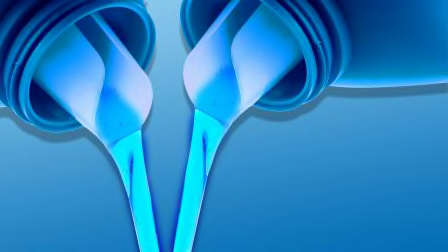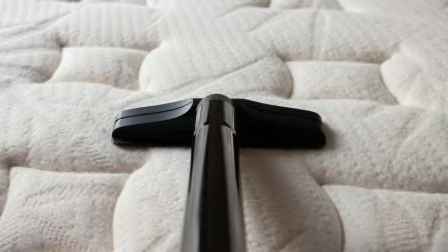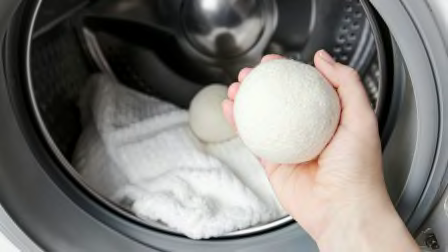Could Tide Evo Change the Way We Do Laundry?
It’s not a sheet, it’s not a liquid. So how does P&G’s new laundry detergent “tile” work? We washed 12 loads to find out.
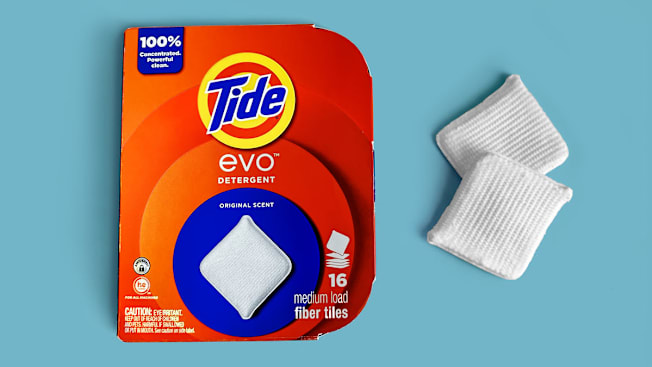
When I do laundry, I don’t like powerlifting 7-pound liquid detergent jugs or tossing synthetic PVA pods into the washer. All of that plastic and potentially harmful polymers weigh heavily on my conscience. Laundry sheets don’t do it for me, either—I find they don’t clean well enough, which has been confirmed by my colleagues in CR’s laundry test lab. So on laundry day, I still settle for a high-performing liquid detergent—generally the most effective type, based on our tests—hoping that my guilt will wash away with the dirt and stains.
So when Procter & Gamble introduced Tide Evo, a dissolvable fiber detergent square promoted as the “new evolution of clean,” it sounded like a potential game changer.
“Our primary goal was to address evolving consumer needs and make laundry a breeze,” Ammie Walter, senior brand director of Tide Evo, said in a press release issued after the product was unveiled at SXSW in March 2024. “We wanted to create a detergent that effortlessly fits into busy lives, prioritizes sustainability by eliminating water and fillers, and, most important, adds a touch of enjoyment to the laundry process,” she said.
Make laundry more enjoyable? That’s a bit of a moonshot, if you ask me. But our home evaluation did reveal that this new form of detergent has its strengths—though maybe not enough to make me look forward to wash day.
What Is Tide Evo Laundry Detergent?
Ten years in the making, P&G says it developed Tide Evo for consumers seeking a convenient and environmentally friendly cleaning option. Here’s how P&G describes its new tile laundry detergent:
It’s sustainably manufactured and packaged. According to P&G, Tide Evo tiles are manufactured in its Alexandria, La., factory powered by renewable energy. The tiles are designed for energy-saving, cold-water washing. They don’t require plastic jugs, added water, or polymer wrapping (although PVA is used as a binding agent). The cardboard box they come in is recyclable and Forest Stewardship Council certified. “This initiative is part of our broader strategy to innovate responsibly, focusing on products that support sustainability without compromising quality,” says P&G fabric care scientist Kim Romine.
It’s powered by strong ingredients. Tide Evo tiles consist of six layers of compressed, dehydrated soap fibers woven into a flat 2x2-inch square. They’re formulated with concentrated stain- and soil-removing surfactants, enzymes that break down complex stains, whitening agents, suds reducers, fragrance, and other cleaning agents.
It’s dissolvable and biodegradable. “The fibers are designed to dissolve instantly and completely in water, providing an effective clean in all water temperatures, though they are optimized for cold water use to maximize energy savings,” says Romine. She says Tide Evo’s surfactants, which make up the majority of the product, are biodegradable, according to the testing guidelines of the Organization for Economic Cooperation and Development.
It’s convenient. Boxed Tide Evo tiles come vertically stacked on end, like vinyl albums at a record store. Just toss one into the empty washer drum before loading clothes and push “Start.” P&G recommends using one tile for small or medium loads and two tiles for large or heavily soiled loads.
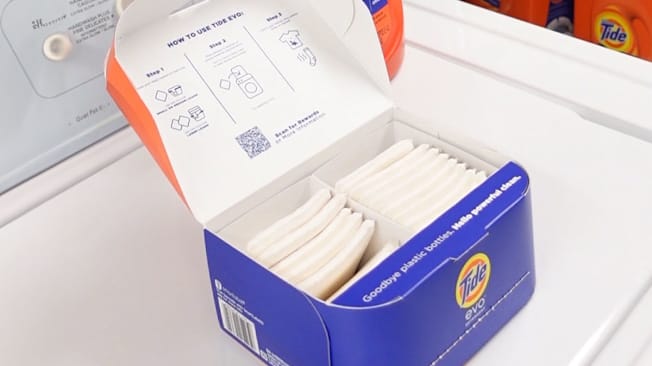
Photo: Consumer Reports Photo: Consumer Reports
Here’s How Tide Evo Worked in Our Washers
In my experience, no laundry detergent brand has hit the sweet spot between efficiency, performance, convenience, and eco-friendliness (most either lack strong ingredients or use harsh chemicals). For example, Earth Breeze eco-friendly laundry detergent sheets came up short on cleaning performance in both our lab tests and a home evaluation. Could Tide Evo do better?
CR’s laundry lab currently rates dozens of liquid, pod, and sheet detergents, some of which claim to be gentle or sustainable. In our lab tests, we launder fabric swatches stained with blood, body oil, chocolate, coffee, dirt, grass, and salad dressing. Our testers use a colorimeter (a device that measures color intensity) to gauge how much of the stain remains on each laundered swatch.
When Tide Evo is widely available, we’ll buy it and put it through those same lab tests. For now, we simply wanted to see what it was like to do our own laundry with this new detergent form. Here’s how it went.
Upon unboxing, I was a bit overwhelmed by Tide Evo’s scent (more on that later). I don’t have allergies but I did sneeze a couple of times. Post-wash, it left my laundry with a nice bouquet (to me)—though it could be annoying (to you), depending on your preference.
Wash directions are inside the box lid, but using Tide Evo is as easy as using pods—just toss a tile into the drum before loading your laundry. They appeared to dissolve quickly, and didn’t produce a ton of suds (as seen through the window of Deb’s front-loader). That may be a good thing, as too many suds can cause a washer to use excess water. In all, we washed 12 loads with Tide Evo on a variety of settings, from normal to bulky to heavy soil—primarily with cold water as recommended, but also in warm and hot. In four large loads that included smelly towels, stained cottons, and white items washed in hot water, we used two fiber tiles. Here’s what we washed, and what we observed.
Comforter: First, I went big. I stuffed a black comforter into my 4.3-cubic-foot top-load agitator on the cold wash, bulky setting. Knowing this pushed the limits space-wise, I only used one tile and removed the comforter post-wash to check for residue. None was obvious, but I deployed the extra rinse cycle anyway, then dried it. It came out clean, with a faint whiff of fragrance.
Mixed loads: Deb washed a mixed load (including jeans smeared with garden dirt) in warm water. Tide Evo removed the dirt stains and “everything else came out as clean as when I use the usual Tide or Persil liquid,” she says. My two mixed loads, washed in cold water, also cleaned well, stains and all.
White clothes: We both washed whites (bath and hand towels, socks, etc.) in hot water, tossing in a few dingy, soiled sports socks for good measure. Tide Evo reduced the heavy soil to gray, but the results fell short of bright white, even after Deb tried a two-tile follow-up wash.
Stained fabrics: I intentionally stained a small load of older, dark cottons (boxers, shorts and T-shirts) with a dab of olive oil, soy sauce, and even risky raspberry syrup. I tossed in a salad dressing-stained white shirt for kicks. (I know, I know—never mix colors. Sorry, Mom.) To my surprise, most stains were removed on the first wash with one tile. There was one exception—an accidental olive oil spill from my daughter’s graduation tapas dinner stained my favorite black polo. I called in two-tile reinforcements for a bigger dark cotton load and that cycle finished the job. (But always inspect closely before drying so stains don’t lock in.)
Sweaty workout clothes: After a long walk on a hot day, I threw my sweaty shirt, shorts, and socks into a small cold load to see if Tide Evo was up for the job—it was. Deb, a jogger, washed colorful synthetic exercise clothes in cold water. To her surprise, it all came out clean and fresh-smelling. Not an easy task since smelly synthetics are hard to clean—their moisture-wicking technology can trap sweat and body odors deep in fabrics. (We advise washing them on the delicate cycle in either warm water or the hottest water the label recommends before drying on low heat.)
What We Learned About Tide Evo
Our firsthand experience left both Deb and I satisfied that Tide Evo could get clothes clean—even those with more challenging stains. Our evaluation also left us with some additional impressions that could weigh in on whether we’d become loyal users.
- It removes odors well. Aided by its fresh scent, Tide Evo did a very good job eliminating odors from old socks, sweaty clothes, and stinky towels and washcloths. In fact, I found it did a better job leaving laundry odor-free than Tide liquids with no scent. Personally, this evaluation may inspire me to try a scented detergent just for towels and sweaty clothes.
- But, the scent could knock you back. Pre-wash, Tide Evo tiles will trigger your nasal nerves, and possibly allergies if you’re sensitive to fragrances. The tiles come in two scents: Spring Blast and Original. The aroma of the Original-scented Evos we purchased was intense upon unboxing (maybe because the initial whiff takes in 16 tiles at once; I can only imagine the power in a box of 44). But post-wash, the scent on your clothes is less potent. Romine said, however, that P&G is considering a Tide Evo formula for sensitive skin.
- Forget pretreating stains. Of course, pre-treating stains isn’t an option with fiber tiles. Romine says Tide Evo eliminates the need for most pretreating, but for particularly stubborn stains, she suggests dabbing with a liquid detergent.
- This detergent can get expensive. Tide Evo’s price per box falls in line with other detergents, but you’re getting fewer loads per box compared with liquids and pods. We picked up a box of 16 for $9.94—that’s 62 cents a load if you use one tile each time. It was also sold in boxes of 22 tiles for $12.94; 30 tiles for $15.94; and 44 tiles for $19.94. If you wash large family loads, Tide Evo’s box could empty out pretty quickly, along with your wallet. For comparison, Amazon prices 84 ounces of liquid Tide Oxi+ at 22 cents per load.
- Evo is (kind of) eco-friendly. Tide Evo’s box is recyclable, so it spares you the hard plastic and added water of liquid laundry jugs. Romine says the fiber tiles are biodegradable. But that’s as eco as Evo gets. The brand makes no attempt to pass itself off as a competitor to laundry sheets that claim only earth-friendly ingredients; unlike laundry sheets from Earth Breeze and Tru Earth, Tide Evo doesn’t claim to be hypoallergenic, vegan, or free of parabens, phosphates, bleaches, or dyes. The tiles’ “6 layers of pure cleanliness” include PVA and perfume, as well as sodium laureth sulfate and sodium lauryl sulfate (fragrance indicators) that can affect people with sensitive skin conditions like eczema and psoriasis. P&G says it is considering a sensitive skin Tide Evo formula, but for now, if you’re concerned about harsh chemicals, PVA, or potential fragrance allergens, Tide Evo may not be your best choice.
- You might want to keep the detergent tiles out of reach. Like detergent pods, the ingredients in the fiber tiles are highly concentrated and dissolve easily, so even if they don’t look as enticing as colorful detergent pods, accidents could happen if they fall into the wrong hands. Since Tide Evo’s cardboard packaging makes them easier to access than pods, it might be wise to store these where young children or compromised adults can’t access them.
The Last Word (for Now)
While Evo narrowly misses that pure sustainable sweet spot, it may bring us closer to the bullseye—as an efficient laundry detergent that reduces the plastic-waste guilt that weighs on our conscience. Procter & Gamble may have invented the next best thing, for now: a novel approach to laundry with some significant benefits.
I’m not sure whether Tide Evo makes laundry more enjoyable, as P&G’s Walter suggests. Alice from "The Brady Bunch" is the only person I know who relishes this tedious chore. But like Alice, Tide Evo does make laundry less of a hassle. It’s easy to use and effective and offers an option for those looking to reduce their plastic use. If, like me, that’s the balance you’re looking for, Tide Evo may be one way to get there. Once the product is released more widely and we can buy more tiles to test in the lab, we’ll see just how well it stacks up against the competition in our intentionally difficult laundry detergent tests.






























